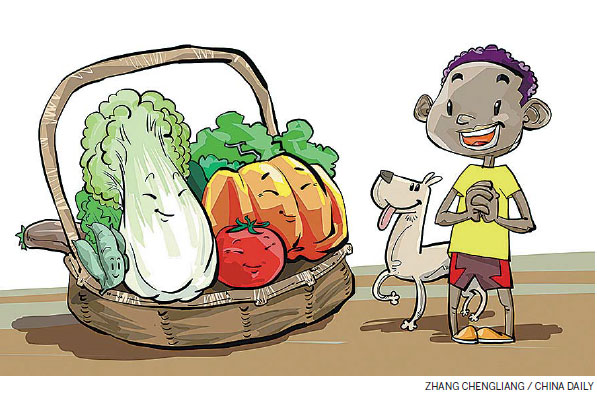Africa must raise food production

On menu: new ideas such as growing Chinese greens and better technology, infrastructure and training
Given that Africa boasts of an abundance of arable land, it is ironic that it cannot sustain its food production despite the general worldwide improvement in food security.
A report by McKinsey & Co in 2010, Lions on the move: The progress and potential of African economies, said Africa had about 600 million hectares of uncultivated land, about 60 percent of the global total.

This has been attributed largely to a lack of increased investment in boosting agricultural production. Most African countries are struggling to fund agricultural development strategies under which farmers would use modern technologies and techniques while having access to market information regarding demand and supply dynamics.
Governments should invest in research and development not only on African indigenous plants but also from far and wide. Chinese vegetables have been making appearances in farmers markets, and locals are warming up to them. Vegetables such as the Chinese cabbage are easy to manage, they mature quickly and are highly nutritious, thus supplementing the local menu while at the same time sustaining supply to the markets.
In the Abuja declaration on fertilizer for the African Green Revolution, heads of state and government adopted the Comprehensive Africa Agricultural Development Program, which calls for agricultural production to grow 6 percent a year. This strategy aims to restore agricultural growth, food security and rural development in Africa.
It is encouraging that since 2008 many African countries have implemented new strategies based on the program. By 2011, 26 African countries had formulated agriculture strategies and signed the program's compacts, 15 of which are at various stages of implementation in countries such as Burkina Faso, Malawi, Mali and Rwanda.
But governments are still struggling to increase funding for this essential sector. The focus has energetically shifted toward expanding infrastructure.
A lot of agricultural development has been achieved through nongovernmental partners. But even if these organizations align their activities to complement government programs, the groups can only do so much, especially in rural areas where poor infrastructure coupled by high levels of poverty among citizens prevail.
These mainly small-scale farmers continue to use traditional methods. Most cannot afford farm inputs such as fertilizer and still rely on rainfall to water their farmlands. Climate change has aggravated the situation as prolonged rainfall and drought destroy the little investment made.
At the same time, the rising population in cities is forcing more and more land to be converted into housing units. Previous farms on the periphery of urban areas have therefore ceased to supply vegetables to the urban dwellers easily and at reasonable prices. So supply is expected to come from rural areas.
In Kenya authorities have tried to encourage farmers to revive planting of indigenous vegetables. Besides being drought resistant, they are highly nutritious, easy to grow, fast maturing and require minimal management. This is the ideal way of ensuring that food gets to the markets and combats malnutrition.
Though vegetable production has improved markedly, the cost of fertilizers and the supply chain have not been adequately dealt with. Fluctuating oil prices and poor roads have pushed up transport costs to the markets, making produce costly.
In addition, access to market information has been poor. There have been instances where there is a market glut in one area even as another is experiencing starvation and thus exorbitant prices for food. Farmers are unable to take advantage of prevailing market dynamics, especially at a time when farm inputs such as fertilizer are still expensive.
However, while considering the Abuja declaration, governments are on the right path toward improving the food production of the continent, which it is believed can feed itself and the world at large.
First, farmers should be encouraged to use modern technology and techniques such as irrigation, fertilizer and herbicides. Highly subsidized fertilizer will deliver increased yields.
Second, there should be increased focus on agricultural extension services by which professional officers reach farmers on their farms. In the recent past, governments such as Kenya have reduced investment in such services, leaving farmers on their own. However, local authorities can take up these responsibilities and launch monitoring and evaluation plans to plug gaps.
It is heartening to see that institutions of higher learning such as Egerton University in western Kenya have partnered with the local media to disseminate advice on how farmers can address various challenges facing them today. However, the interactive forum is limited to those who can access the medium.
Moreover, good land policies should control the conversion of arable land into housing units. There has been sector-wide demand for local authorities to zone land. This will not only monitor and control expansion but may also result in policies that would see such land retain its farming value.
By the same token, town dwellers moving away from cities should be encouraged to keep kitchen farms and plant crops such as Chinese vegetables that need light investment while producing healthy yields. In the long run these may be commercialized with good land use.
The author is a business writer in Kenya. The views do not necessarily reflect those of China Daily.
(China Daily Africa Weekly 10/23/2015 page10)
Today's Top News
- Loan subsidies set to boost consumption
- Young people redefining summer tourism
- Protectionist's paradox could revitalize WTO
- Anti-aggression spirit still inspiring today
- Momentum builds in A-share market
- China stands firm against maritime intrusions by US, Philippine vessels






























